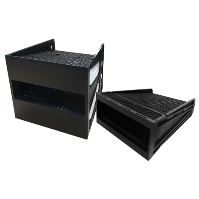4 Ways to Use Commercial HVAC to Alleviate Allergies in Your Space

I think that we can all agree that allergies are the worst. Here are a few statistics to back this theory up:
Allergies, also called hay fever or allergic rhinitis, affect between 10%-30% (19.2 million) of the adult US population and up to 40% (5.2 million) of children, making it the fifth most common chronic disease. (Source: AAFA)
The most common indoor/outdoor allergy triggers are tree, grass and weed pollen, mold spores, dust mites, cockroaches, and cat, dog, and rodent dander. (Source: AAFA)
Allergic rhinitis, often called hay fever, affects 5.2 million of the children population and 19.2 million of the adult population. (Source: AAFA)
Number of weeks by which the ragweed pollen season increased between 1995 and 2015 in U.S. and Canada, likely because of global warming: From 1 to 3 1/2. (Source: WebMD)Percentage of indoor pollutants in U.S. homes versus outdoor pollution: 2 to 5 times higher. (Source: WebMD)
More than 50% say allergies affect daily quality of life. (Source: Allergy Asthma Network)
Allergies really are the worst. With so many adults and children suffering from allergies, improving indoor air quality and alleviating allergies should be a top priority for any building owner, facility manager, and engineer. When these people suffer from allergy symptoms day in and day out, it can directly affect their health, productivity, and comfort in any space. You can make slight changes to your application to help increase indoor air quality and decrease allergens, creating a safe and healthy space for building occupants. In some cases, these minor changes can even save you money in the long run!
Here are 4 ways to use your HVAC unit to alleviate allergies:
1. Invest in High Quality Filters: One of the easiest ways to improve indoor air quality is to invest and install the proper high-quality filters in your space. When you make the investment for good filters, these filters can catch those microscopic particles that cause allergy symptoms before they reach building occupants. With an increase in indoor air quality, building occupants will be healthier, more comfortable, and most likely more productive.

Every application has unique needs, but your Hoffman salesperson can talk you through the best options that will alleviate allergies and increase the indoor air quality in the building.
2. Use an Air Purifier: Commercial air purifiers can be installed in the ductwork, or they can
 be placed and moved around any space, depending on the equipment you choose. These air purifiers work to remove dust, mold, bacteria, and viruses from the indoor air, helping to increase overall indoor air quality. It can even trap pet dander and other allergens. With an air purifier, you can alleviate allergies for building occupants year-round, even in the heavy symptom months.
be placed and moved around any space, depending on the equipment you choose. These air purifiers work to remove dust, mold, bacteria, and viruses from the indoor air, helping to increase overall indoor air quality. It can even trap pet dander and other allergens. With an air purifier, you can alleviate allergies for building occupants year-round, even in the heavy symptom months. Our manufacturer friends at Price Industries have a great, portable air purifier option that works great if you need to move it to different rooms or areas of the building. Price’s Room Air Purifier is designed to continuously cycle air through a HEPA filter, cutting unwanted dust particles, germs, and contaminants.
3. Reduce Humidity to Limit Mold Build Up: One terrific way to reduce humidity is to ensure that your building has the proper ventilation to prevent excessive moisture and bacteria. In turn, with a reduction of moisture and bacteria, mold growth will decrease or be prevented altogether. Without mold buildup, building occupants are less likely to experience those allergy symptoms that mold can cause throughout the year.
Greenheck has a great line of ventilation solutions for (almost) every application. Whether you're looking to upgrade the ventilation in your school, office space, warehouse, or restaurant, Greenheck and Hoffman & Hoffman have you covered.

4. Schedule Regular Maintenance to Keep Filters Clean and Unobstructed: Regular maintenance can really be make-or-break for your HVAC system. With regular maintenance, your commercial HVAC system can run smoothly and efficiently, which can directly affect allergies, health, safety, and comfort. During the scheduled maintenance, your HVAC technician should check to make sure the filters are clean and unobstructed, which can cause allergy symptoms if not checked regularly. Scheduling regular HVAC maintenance can also save you money, so make sure you book those out for the year!

Blog source and images: Camfil, Greenheck, and Price Industries
// about the author

 Hoffman & Hoffman Marketing
Hoffman & Hoffman Marketing
The marketing department at Hoffman & Hoffman is focused on communicating different commercial HVAC solutions to the industry. We often share manufacturer information to help engineers, contractors, and building owners make informed decisions.















